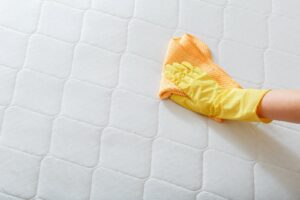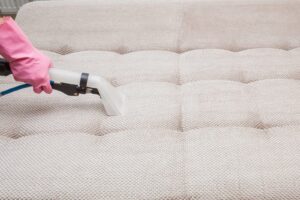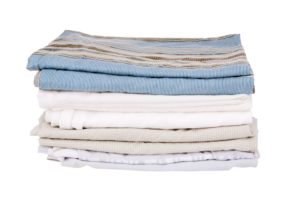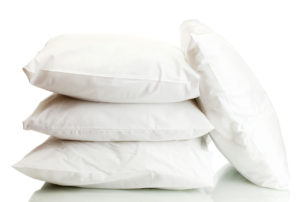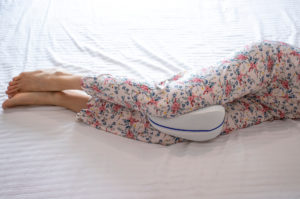Down vs. Down Alternative Comforters
- Down comforters are filled with the soft feathers underneath a duck or goose’s outer feathers, while down alternative comforters use other natural and synthetic materials to mimic real down. People who enjoy warm and plush bedding and don’t mind spending more on durable materials should appreciate a real down comforter. Sleepers on a budget, hot sleepers, and animal-conscious shoppers may prefer down alternative options.
Comforters are layered bedding with cozy outer shells and soft inner materials that keep you warm throughout the night. In contrast to duvets with changeable covers, comforters are all-in-one solutions with connected covers that encase and surround the fill material. With many comforter options available on the market, it can be difficult to narrow down your options.
We’ll take a closer look at down and down alternative comforters. These comforters have a similar feel, but they benefit different sleepers depending on their needs and preferences. We’ll explain what down and down alternative comforters are, as well as their pros and cons. Then, we’ll go over how they contrast in performance and appeal to unique sleeper types.
What Is a Down Comforter?
A down comforter is filled with the fine feathers found underneath a duck or goose’s outer feathers. Down is exceptionally soft and airy, without the rigidity and roughness of the outer feathers. Comforters that use down have a plush hand feel and a lofty, voluminous look.
Down is also a highly durable material, so down comforters should hold up well over time, provided the cover material is high quality as well. Down’s natural insulation properties are another standout feature, offering a bit of cozy warmth. Meanwhile, air easily circulates through the feathers to prevent you from overheating.
Fill Power, Explained
Fill power refers to the number of cubic inches filled by one ounce of down. The volume of down inside a comforter largely determines how well it regulates temperature. Lower fill power comforters allow more airflow, helping to keep you cool. In contrast, higher fill power comforters trap more heat since they have less space for air circulation. Fill powers below 500 are considered low, and those over 700 are considered high. All-season down comforters generally range from 600 to 700 fill power.
Down Comforters and Allergies
Many people have misconceptions about whether down products cause allergy flare-ups. Research suggests that down itself is no more allergenic than alternative materials. Dust mites and mold from unwashed down can cause flare-ups, but these allergens can affect almost any bedding material. Those concerned about potential allergens in a down comforter should look in the product description to see if the company washes the down to remove dirt and dust.
| Pros | Cons |
|---|---|
|
|
What Is a Down Alternative Comforter?
Down alternative comforters are filled with a fibrous material that mimics the feel of down. Many down alternative options also have a plush, warm feel and lofty look, and are great options for customers who prefer not to buy real down.
Down alternative comforters can be easier to care for than those using real down and they are often more affordable, making them appealing to shoppers on a budget. They can also be more breathable than real down, making them better options for hot sleepers. Animal-conscious or vegan shoppers may also prefer down alternative options since most are made without animal products.
What Is Down Alternative Made Of?
Down alternative fibers can be made from several natural or synthetic materials. Comforters with synthetic materials often use PrimaLoft, polyester fibers, or microfiber. Some popular natural materials include cotton, silk, and wool.
These alternatives can’t simulate real down’s natural fluffiness and warmth perfectly, but they are great options for certain sleeper types. Many down alternatives are more hypoallergenic than real down, making them great options for sleepers with allergies.
Down Alternative Comforters
| Pros | Cons |
|---|---|
|
|
Down vs. Down Alternative Comforters
Down and down alternative comforters have a similar plush and lofty feel and help keep you warm throughout the night. Real down tends to be more expensive and retain more warmth, but has a higher potential for allergens. Meanwhile, down alternatives are often less expensive and cooler, but can’t perfectly replicate the plushness of real down.
| Down Comforters | Down Alternative Comforters | |
|---|---|---|
| Fill | Down is made from the plumage under a duck or goose’s feathers. It forms in clusters and has a distinctly soft feel. | Down alternative comforters can contain natural or synthetic materials. PrimaLoft, polyester, and microfiber are popular options, while cotton, silk, and wool are rarer. |
| Temperature Regulation | Down is a naturally insulating material that gives bedding a cozy and warm feel. | Down alternative is often not as insulating as real down, but it still offers warmth and comfort. |
| Breathability | A down comforter can be exceptionally breathable if it has a low fill power, but higher fill powers tend to trap heat. | Down alternative comforters are generally less likely to cause overheating. |
| Allergens | Down can trap dust, mold, or mildew and affect allergies. Many companies wash down fill to mitigate this issue. | Down alternative fibers often resist allergens. |
| Durability | Down is one of the most durable bedding materials. | Down alternative fibers tend not to last as long as real down. |
| Comfort & Feel | Down comforters have a distinct plush and lofty feel that keeps you warm throughout the night. | Down alternative comforters mimic the feel of real down, but they can not replicate it exactly. |
| Cleaning & Care | Down comforters often require professional cleaning to avoid damage. | Most down alternative comforters are machine-washable and easy to clean. |
| Price | Most people can expect to spend at least $150 on a down comforter, but many cost more. | Down alternative comforters come in a wide range of prices. Some cost less than $50 and others can cost more than $200. |
Which Is Best for Your Needs?
If you prefer an exceptionally soft and lofty comforter, it’s hard to beat the feeling of real down. We recommend choosing down if you prefer a cozy warm top layer, and are willing to spend a bit more on a comforter made with one of the most durable bedding materials.
You may prefer a down alternative comforter if you sleep hot since they tend to regulate temperature better. Down alternatives can also resist dust and other allergens better than real down. Most down alternative comforters don’t contain animal products, making them great options for vegan and animal-conscious shoppers as well.
You Should Go for Down Comforters If …
- You enjoy cozy and warm comforters
- You’re willing to spend a bit more on a comforter made with durable materials
- You prefer exceptionally soft and lofty comforters
You Should Go for Down Alternative Comforters If …
- You are sensitive to allergens like dust, mold, or mildew
- You are animal-conscious or vegan and prefer not to buy bedding made with animal products
- You are a particularly hot sleeper who overheats with real down

Still have questions? Ask our community!
Join our Sleep Care Community — a trusted hub of sleep health professionals, product specialists, and people just like you. Whether you need expert sleep advice for your insomnia or you’re searching for the perfect mattress, we’ve got you covered. Get personalized guidance from the experts who know sleep best.

